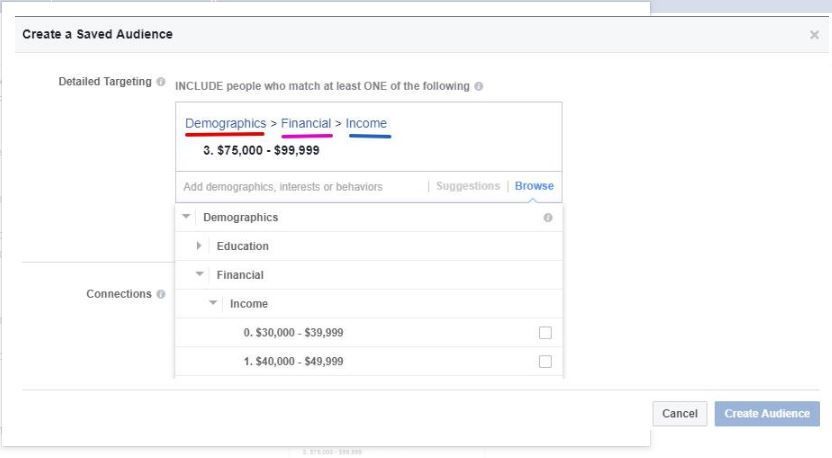Byte #5: Targeting based on income levels
- Digiclue Editor

- Jan 12, 2018
- 4 min read

I must first thank Mr. Arun Kumar for asking this question from us. I spent 6 hours researching on this topic, despite working on this problem in the past.
I wish to explore this question through 5 different articles on Digital Marketing (DM). They'll be:
(i) Sales Funnel and its significance in DM?
(ii) User Journey and its significance in DM?
(iii) Customer Mapping and its significance in DM?
(iv) Product Proposition and its significance in DM?
(v) Targeting Case study: Based on any DigiClue's followers specific problem statement.
Let me begin with something simple. How do we target someone based on income levels?

1. Trust:
In an utopian world, where people don't fear privacy issues, update information on a timely basis and are honest about the facts they expose, this should work. And don't worry, there actually exist subsets where people are this utopian. The easiest place to discover this would be job portals or social media platforms (when someone is actively searching for jobs). We will cover in a separate article, how to target job-seekers on social media?.
For these people, when you post an advertisement, just go to the Ad-Manager provided by the site and choose the necessary category based on income level. Pretty, straight-forward right.
2. Triangulation:
Some Ad-managers like Facebook (in certain countries) and Google try to estimate a user's income level based on the content they share and interact with on the internet. Sometimes the purchase these prediction results from 3rd party companies like Acxiom https://www.acxiom.com/ or Crayon Data http://www.crayondata.com .
The only catch here is that platforms like FaceBook don't allow Page-admins to be able to target their ads based on the income levels of some other country. For example, if you were the admin of a clothing brand in India, you can't access the triangulated income category levels of the US for some odd reason (Since facebook wants to keep this 3rd-party data predictions localised or probably wants to monetize it in the future). Already, over 15% of your ad-spend goes towards procuring the data that companies like Facebook buy from other companies.
In certain countries, which lack the kind of infrastructure to gather massive credible data on its citizens, you may not see this feature available. Always use a local user to determine whether the data is available (Like a US admin for a US-targeted ad.) Simply mentioning that a company is from the US while creating the profile sitting in India won't work. Its probably time to call your overseas friends.

3. Intuitive hack:
This maybe partially unethical, but that is left to your personal judgement. This technique has worked for me in the past and I would highly recommend it to anyone who is an amateur entrepreneur, probably bootstrapped and doesn't have a rich Angel investor.
Let's take a case-study: How did I sell That1Card's Rs.1000 invitations to HNIs?
We call the whole process customer lifecycle management. It mainly consists of 4 parts - lead generation , lead nurturing, sales and post-sales. For now we'll only focus on what I did for lead generation.
Least ethical | Least expensive: You remeber those porn website disclaimers that ask you to ascertain whether you are 18 years old. I got my idea from there and created a simple landing page on wordpress.com that allowed for free American Express Credit Cards, free Audi doorstep test-drive, Mahindra Holiday package discount and Country Club membership discounts. Obviously, people had to mentioned their income bracket in the form (and they were honest about it, since they expected they would have to show proof eventually.) I generated a lead database from here of HNI individuals. I also left some other cues which also helped me predict if they would have the need for an invitation card which I will explore in a separate article on customer mapping.
Moderately Ethical | Moderately expensive: I created job postings that would attract people for a varying number of profiles and posted them on several employment platforms. I understood that higher up the or that allowed for free American Express Credit Cards, free Audi doorstep test-drive, Mahindra Holiday package discount and Country Club membership discounts. Obviously, people had to mentioned their income bracket in the form (and they were honest about it, since they expected they would have to show proof eventually.) I generated a lead database from here of HNI individuals. I also left some other cues which also helped me predict if they would have the need for an invitation card which I will explore in a separate article on customer mapping.
Most ethical | Most expensive: I went to Housing.com's Data Science Lab's section and chose the 'Heat Maps' option. Based on the average selling/rental price per square foot in a certain area, the map indicated which areas were the most expensive. Coupling those target areas with a certain age group and education level I was able to find prospects with an expected disposable income level
I hope you've enjoyed this article. This topic is a major motivator for us to explore so many other aspects of digital marketing that lead up to this. Keep looking out for us!
Takeaway:
Use https://www.tryadhawk.com/ to simplify your digital marketing campaigns with respect to income levels and net-worth
Featured:
Checkout Akkara -> https://goo.gl/fDEF9w . Akkara is a non-profit social entreprise striving to make 'Farming as a Sustainable Business'. The one good thing about this site, is how they've attempted to pivot on a transformational business concept using a frugal CMS (content management system) like Wix.
Byte #6:
Sales funnel and DM







Comments